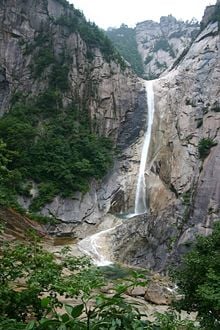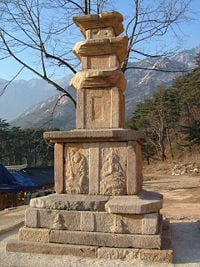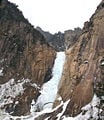Kumgangsan
| KÅmgangsan ("Diamond Mountain") | |
|---|---|
| Korean Name | |
| McCune-Reischauer | KÅmgangsan |
| Revised Romanization | Geumgangsan |
| Hangul | ê¸ê°ì° |
| Hanja | éåå±± |
| Statistics | |
| Height | 1,638 meters |
| Location | KÅmgangsan Tourist Region, North Korea |
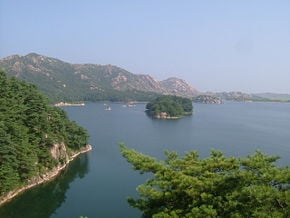
| |
KÅmgangsan or The Diamond Mountain is named for its hard sparkling cliffs, which look like KÅmgangsÇk (ê¸ê°ì), the Korean word for diamond. KÅmgangsan is the second highest mountain in North Korea, with its highest peak, Pirobong, reaching 1,638 meters. KÅmgangsan, part of the Taebaek mountain range which runs along the eastern edge of the Korean peninsula, is located at 38.58 N latitude, 128.17 E longitude, in the recently created KÅmgangsan Tourist Region, formerly part of KangwÅn Province. KÅmgangsan was the first place in North Korea opened up to allow visits by South Korean tour groups, beginning in 1998.
KÅmgangsan is a national treasure for the Korean people, with its life-giving beauty. Long considered a source of particular power and spiritual renewal, the reopening of the mountain to visitors from South Korea bears particular significance as a step toward reuniting the heart as well as the land of the divided Korean peninsula.
Natural Beauty
KÅmgangsan has been known for its beauty since antiquity. It is covered in forests, and the area around KÅmgangsan has some of the highest levels of precipitation in Korea. The mountain not only features a landscape formed by erosion, but also a great number of deep ponds and waterfalls.
The mountain consists almost entirely of granite and diorite, which have been weathered over centuries to create a wide variety of shapes. It is estimated that there are over 12,000 picturesque stone formations, ravines, cliffs, stone pillars and peaks. Major peaks in the northern section include YÇngrangbong (ìëë´, æ°¸éå³°/1,601m), OknyÇbong (ì¥ë ë´/1,424m), SangdÇngbong (ìë±ë´,ä¸ç»å³°/1,227m), and Obongsan (ì¤ë´ì°,äºå³°å±±/1,264m), and in the southern section WÇlchulbon (ìì¶ë´/1,580m), Ilchulbong (ì¼ì¶ë´/1,552m), Chailbong (ì°¨ì¼ë´,é®æ¥å³°/ 1,529m), MirÇkbong (미륵ë´/ 1,538m), Paekmabong ( ë°±ë§ë´, ç½é¦¬å³° /1,510m), Horyongbong (í¸ë£¡ë´,èé¾å³°, /1,403m), and Kuksabong (êµì¬ë´, å士峰 /1,385m).
KÅmgangsan is commonly divided into three areas: Outer KÅmgang, Inner KÅmgang, and Sea KÅmgang, each with different geological and topographical features. OekÅmgang (ì¸ê¸ê°, å¤éå), or Outer KÅmgang with its rough terrain and plummeting waterfalls is considered KÅmgangsan's masculine manifestation, and is noted for the large number of peaks, such as Jipson Peak (rock of ten thousand formations). NaekÅmgang (ë´ê¸ê°, å §éå), or Inner KÅmgang manifests a softer side of the mountains with hundreds of streams and pools, valleys and breathtaking views. Inner KÅmgang's Manpok ravine is popular with tourists. HaekÅmgang (í´ê¸ê°, æµ·éå) or Sea KÅmgang is known for its lagoons and stone pillars. The mountain is called by different names as the seasons turn. KÅmgangsan, Diamond Mountain, in the spring; Bongraesan, verdant mountain in the summer; Pungaksan, autumn foliage mountain in the autumn and Gaegolsan, skeleton mountain in the winter.
There are many old temples around KÅmgangsan, although not all are preserved in good condition. Probably the best known temples are Jangan-sa and Maha-yon. Other features of the area include: Sea Manmulsang, KÅmgang Gate, Samil Lagoon, Piro Peak, Myongyong rock, the Baektap ravine, Manmulsang, Kuryong pond, the Upper Pal pools, Sujong Peak, Ongnyu ravine, the Hanha Stream, and the Sibi waterfalls.
KÅmgangsan Tourist Region
Since the Korean war in the early 1950s, until recently, there had been no surface traffic permitted between North and South Korea, and the few South Korean tourists who were permitted to visit the North had to fly there via a third country, usually China or Japan. Since 1998, South Korean tourists have been allowed to visit KÅmgangsan, initially traveling by cruise ship, but recently more commonly by bus. In 2002, the area around the mountain was separated from KangwÅn Province and organized as a separately administered Tourist Region. The land route connecting the region to South Korea was re-opened in 2003. A rail link exists on the North Korean side up to the border, but as yet no tracks are laid between Gangneung and the border in South Korea.
The KÅmgangsan Tourist Region is thought to be one way for the North Korean government to receive hard currency from abroad. Therefore the official currency of the tour is neither the South Korean won nor the North Korean won, but the US Dollar. Since 2003 the food and lodging services for the South Korean tourists have been provided by North Korean staff. The area is being developed by Hyundai Asan, who operate the tours and also have plans to expand the site with a proper ski resort to complement the current sleigh course, and complete golf courses. These plans for expansion, however, are in their earliest stages. Since 1998 an average of approximately 200,000 tourists a year have visited the KÅmgangsan area. In June 2005 Hyundai Asan announced the one millionth South Korean visitor to the area.
In July 2008, Park Wang-ja, a 53-year-old South Korean tourist, was shot twice and killed when she entered a military area, according to the North Korean government. She entered the military area by crossing over a sand dune. Forensic tests suggest that she was standing still or walking slowly when shot. This contradicted the North Korean claim that she was running and did not heed warnings. Immediately after the shooting, the South Korean government temporarily suspended tours to the resort. In August 2008 the North Koreans announced that they would expel "unnecessary" South Korean workers from the resort.[1] Before the closing of access after the 2008 shooting, a few Americans were also allowed to visit by arranging tours through a South Korean tourism agency.
Natural wonders of KÇmgangsan
The Diamond Mountain is one of the most spectacular tourist sights in Korea, including ragged cliffs, waterfalls, lagoons and mineral springs, rock formations, peaks and valleys.
Outer KÇmgangsan
- Manmulsang (Ten Thousand Things) is an area of fantastically shaped cliffs and rocks. At the entrance to Manmulsang is a group of three enormous standing rocks named the Three Fairies (SamsÇn). Other rock formations of every size and shape include Ansimdae (Peace of Mind Lookout), at the opening of the Manmulsang area, Mangjangcheon Spring, with its sparkling water and Haneulmun Gate (Heaven's Gate), a round hole in the stones, that looks like a gate to heaven.
- Kuryong Falls (Nine Dragons Waterfall), with a drop of 74 meters, are an impressive site, one of Korea's three most famous waterfalls. Legend says that nine dragons once inhabited Kuryong Lake, the pool at the foot of the falls. Hiking further up from Kuryong Lake, you can reach Kuryong Rock, with a spectacular view of deep valleys and high elevation lakes.
- Okryudong Valley the most picturesque valley in Outer KÇmgang, containing Okryudam, KÇmgangsan's largest mountain lake.
- Sangpaldam (Upper Eight Pools) is located across the Yeondamgyo bridge above the Kuryong Falls and up 370 steep steel stairs is the Kuryongdae Cliff observation point, 880 meters above sea level, giving a spectacular vies of the Upper Eight Pools.
- Sejongbong Peak appears to the left as you move from Okryudong Valley to Kuryong Falls, and gives a clear good view of Outer KÇmgang and Birobong Peak.
- SujÇngbong Peak High above to the northwest of OnjÇngri, SujÇngbong sparkles with granite and rock crystals after each rain. There is a large plateau at the peak where one thousand people can rest after their climb and enjoy the view.
- Cheonseondae Cliff offers a stunning view of Outer KÇmgang.
- Mangyangdae Cliff shows several of KÇmgang's peaks, including Birobong Peak and also offers a bird's eye view of Sea KÇmgang.
- DongsÇkdong Valley, between JipsÇnbong Peak and Sejonbong Peak can be found the YÇnchundae area where spring first arrives in KÇmgangsan every year. DongsÇkdong Valley also offers a view of the East Sea.
Inner KÇmgangsan
The Inner KÇmgang area has been open to tourists since June of 2007, and features:
- Naegangdong Valley (Inner East River Valley), about 43 kilometers from Outer KÇmgang's OnjÇngri, marks the beginning of Inner KÇmgang, with its rich natural resources.
- The Changansa Temple grounds are is located in Inner KÇmgang, along with Pyohunsa, the only temple on the mountain that is currently active.
- Sambulam a stone carving in Goryeo style shows three Buddhas on the front face and 50 smaller Buddhas on the back face.
- Manpokdong Valley with Inner KÇmgang's best scenery, a rival to the Okryudong Valley in Outer KÇmgang
- PodÇkam, the last remaining hermitage in KÇmgangsan, is an amazing sight perched on a 150 meter cliff, and held up by a lone pole.
- Birobong Peak, KÇmgangsan's highest peak, is located in Inner KÇmgang
Sea KÇmgangsan
The Sea KÇmgang area extends for about 40 kilometers along the coast, and includes many striking rock formations and lagoons.
- Samilpo Lagoon has a circumference of about eight kilometers, is 9-13 meters deep, and is surrounded by 36 low peaks. According to legend, a king once came to the lagoon for a one-day visit but was so amazed by its beauty that he stayed there for three days, hence the name Samil (three days). You can rent a boat at Samilpo. Janggundae and Chungsonggak pavilions offer good views of Samilpo.
- ChilsÇngsÇk and Ipseok Rock
- Haekumgang Seashore beach is open for swimming in July and August, and is marked with the breathtaking rock formations of Haemanmulsang (Ten Thousand Things in the Sea).
- Chongseokjeong, clusters of rocks forming a one km long stretch of cliffs.
- Bongraedae pavilion offers a good view of Samilpo.
- Songdo a rocky island that rises 50 meters straight out of the water.
- YÇnhwadae pavilion gives a view of KÇmgangsan's highest peak, Birobong Peak.
- Waudo Islet is a rocky island in the shape of a cow.
Buddhist temples and Hermitages
Although clear statistics are not available, it is likely that since KÇmgangsan is located in Communist North Korea, the majority of the Buddhist temples are no longer active, and have not been kept in repair to the same extent as mountain temples on the mountains in South Korea. During Buddhism's peak in the Silla and Goryeo periods, there were four major temples recorded as being located on KÇmgangsan, and up to one hundred or more smaller temples in the KÇmgangsan area. Even during the Joseon Dynasty, when Confucianism was favored over Buddhism, the Buddhist temples on KÇmgangsan remained active. However, after the effects of the Japanese occupation, the Korean war and the Communist regime in North Korea, reports show that only one temple on KÇmgangsan remains active today.
- Pyohunsa Temple, in the Inner KÇmgang area, was built in 670 C.E., located about two hours by bus from the Onjunggak tourist complex and the Outer KÇmgang Hotels, is said to be the only active temple remaining on KÇmgangsan. Once one of the most important Seon (Zen) monasteries in Korea, the temple now is said to be inhabited by only two monks. Many of the temple's cultural assets were lost during the period of Japanese rule.
- Changansa Temple, built during the Unified Silla period, was used during the Korean war as the headquarters for North Korea's Fifth Army and to house several hundred South Korean and about one hundred American prisoners of war. By the end of the war, the temple was entirely destroyed.
- Yujomsa Temple was destroyed during the Korean war and not rebuilt.
- Singyesa Temple, built during the Silla Kingdom in 519, with only one stone pagoda remaining since the rest of the temples were destroyed during the Korean war, is being reconstructed by a joint North-South initiative organized by the Jogye Order of Buddhism in South Korea and the Joseon Buddhist Federation, along with government bodies from both Koreas. In 2004 reconstruction began on the temple, financed in part by the Jogye Order and the Korean Buddhist Association, and the temple complex was completed in 2006. Its reopening was attended by leading members of both groups.
- PodÇkam, a small Buddhist temple only 3.3 meters by 5.3 meters in size, built in 627 during hte Goguryeo Dynasty, is located in Inner KÇmgang at the top of a 20-meter-high cliff. Although the temple is still intact, it is structurally unsafe, so nobody goes inside it any more.
- MahayÇnsa, another temple formerly on KÇmgangsan, but destroyed during the Korean war.
Kumgang Jeondo
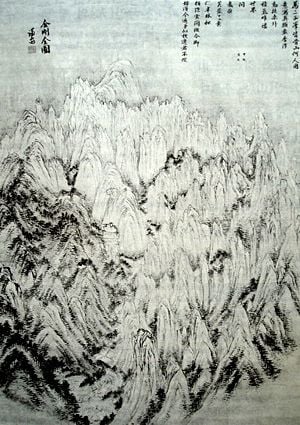
|
| Geumgang jeondo (General View of Mt. Geumgansan or The Diamond Mountains) |
| Jeong Seon, 1734 |
| Ink and light colors on paper |
| 130.7 Ã 94.1 cm |
| Hoam Art Museum |
KÇmgang Jeondo (General view of Mt. KÇmgang) is a famous landscape painting by Jeong Seon during the reign of King Yeongjo. It was classified as the 217th National Treasure of Korea on August 6, 1984. The painting is currently in the collection of the Hoam Art Museum in Yongin, Gyeonggi Province on loan by the owner, Yi Geohui.
While many of his contemporaries painters imitated the latest art trends imported from China, Jeong Seon ignored them, creating unique themes based on Korean landscapes. His catalogue of paintings of KÇmgansan made him famous and the preeminent painter of his time at the age of 37. He eventually painted around 100 images of the mountains which still exist to this day. The artistâs love of the mountains influenced other artists to depict the KÇmgangsan area and even encouraged mapmakers to make maps of the mountains.
Although Jeong Seon made many paintings of KÇmgangsan, this painting is the largest and considered his best. Like many of his paintings, Jeong Seon painted this landscape while actually viewing the mountains. The painting is 130.7 centimeters in height and 94.1 centimeters in width. It is painted with India ink. The painting is of NaekÇmgang, Inner KÇmgang. The painting depicts KÇmgangsan's twelve thousand peaks. The highest peak, Birobong, lies in the background and water flows from it toward a valley called Manpokdong which is divided from the left and right. The high sharp peaks are depicted by the artist with lines painted up and down while he used a dotting brush method to depict the earthen peaks, making them appear relatively soft and lush. This composition harmonizes the contrasting sharp edges of the rocky peaks with the softer earthen peaks.
Jeong Seon included the title of the painting, some comments, and his pen name, Gyeomjae, in the upper right hand corner. The inscription also dates the painting to 1734 when he was 59 years old. The artistâs comments reads:
Even if you visit the mountain yourself and tread on its every nook and cranny, how can your joy be compared with what you feel upon viewing this picture from your bedside?
Gallery
Notes
- â N Korea steps up row with South BBC News, August 3, 2008. Retrieved September 20, 2016.
ReferencesISBN links support NWE through referral fees
- An, Chae-chÊ»Ång. Legends of the Kumgang Mountains. Pyongyang, Korea: Foreign Languages Pub. House, 1990. OCLC 40050868
- Chang, Hyo-sang. Legal aspects of transboundary environment damage caused by the diversion of watercourses in a divided nation a case study of the Kumgangsan Dam. Washington, DC: World Peace Through Law Center, 1987. OCLC 19034506
- Korea (North). The white paper of the Commission of Power Industry of the Democratic People's Republic of Korea details of the construction of the Kumgangsan Power Station. Pyongyang Korea: Foreign Languages Publishing House, 1987. OCLC 59047198
- Zozayong. KÅmgangsan-do = Diamond mountain. Seoul: Emillle Museum, 1975. OCLC 67437031
Credits
New World Encyclopedia writers and editors rewrote and completed the Wikipedia article in accordance with New World Encyclopedia standards. This article abides by terms of the Creative Commons CC-by-sa 3.0 License (CC-by-sa), which may be used and disseminated with proper attribution. Credit is due under the terms of this license that can reference both the New World Encyclopedia contributors and the selfless volunteer contributors of the Wikimedia Foundation. To cite this article click here for a list of acceptable citing formats.The history of earlier contributions by wikipedians is accessible to researchers here:
The history of this article since it was imported to New World Encyclopedia:
Note: Some restrictions may apply to use of individual images which are separately licensed.
